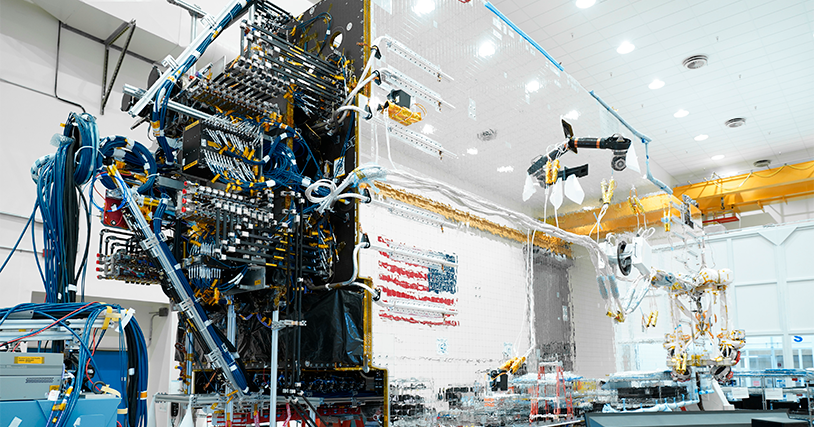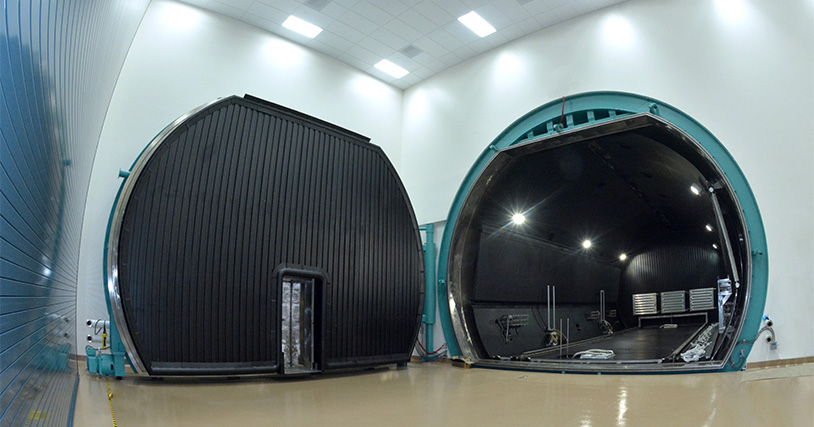Designed to Serve Customers for Years to Come, JUPITER 3 Withstands the Highs and Lows (Temperatures, That Is)

Extensive testing occurs throughout construction of a satellite, particularly one as powerful and complex as JUPITER™ 3. One critical check is Thermal Vacuum (TVAC) Testing, which confirms the satellite can survive the wide range of temperature fluctuations it will encounter in space. The most frequent temperature risk to a satellite is the possible freezing or overheating of components.
As a satellite launches into space, settles into its stationary location or orbital path and provides service over its lifetime (which can last 15 years or longer), it must weather severe temperatures—from extreme hot to brutal cold. With the sun’s light significantly stronger in space than here on Earth, glare and heat can push temperatures around the satellite as high as 120C (248F). At the same time, on the dark shadow side of space, where sunlight is absent, the thermometer can drop as low as minus 170C (-338F). What’s more, satellites often experience extreme hot and cold simultaneously, with one side facing the sunlight and the other away from it.
From Hot to Cold and Back Again
TVAC Testing on JUPITER 3 took several weeks to complete, as the satellite was exposed to extreme hot and cold temperatures––repeatedly. To undergo the tests, the satellite was transported to a massive chamber inside the manufacturing facility where the climate could be manipulated to match the highs and lows of space – imagine a commercial-grade walk-in refrigerator big enough to hold a school bus inside! The satellite was outfitted with hundreds of sensors attached to and surrounding it that feed real-time monitoring data back to the engineering team.

Once the satellite was inside, the chamber doors were closed and all the air inside was pumped out, mimicking the lack air pressure in space. Then, the temperature was lowered in the chamber until every part of the spacecraft reached the same chilly state. This first phase was completed without any of the spacecraft’s power systems turned on––just to get a baseline measure of the spacecraft’s ability to withstand the changing conditions.
With cold testing complete, the team raised the temperature in the chamber to confirm that all the connections securing the components were tight. Because the satellite is made from a variety of materials -- like metals and composites -- that all conduct heat differently, it does not heat up uniformly. Such temperature differentials can cause mechanical motion, like expansion or contraction. Think of a jar with a lid that just won’t budge – running it under hot water can cause the same ‘mechanical motion’ to help get it unstuck. The same phenomenon occurs on a spacecraft during the warming process when components and parts may expand or contract and loosen connections. On a satellite of this size, with thousands of connections, every one of them had to be checked – which is exactly why we conduct this sort of testing.
Turn up the Heat!
Next, we turned on all the equipment and fully powered up the satellite before turning up the heat to test how well the operational systems perform when they run hot in high temperatures. Sensors provided hundreds of data points to establish and validate the thermal model, which the engineers use to predict and analyze how the spacecraft moves heat around.
Looking at the model, engineers determined whether heat was flowing around the spacecraft as planned and predicted. As the electronic components generate kilowatts of heat, the satellite must be able to successfully radiate the heat out through the radiating panels so that it does not overheat.
Together, the three evaluations conducted as part of the TVAC process constituted one full testing cycle. The JUPITER 3 spacecraft then endured the same series of tests, going from cold to hot, then hot to cold, several more times. Because of the complexity of the satellite, the engineering team focused on monitoring a different set of sensors during each cycle. The rigors of TVAC testing continued until the engineering team was satisfied and confident that JUPITER 3 will withstand the harsh conditions of space.
Follow along with us on the Journey to JUPITER 3 as we track the satellite’s progress toward launch.